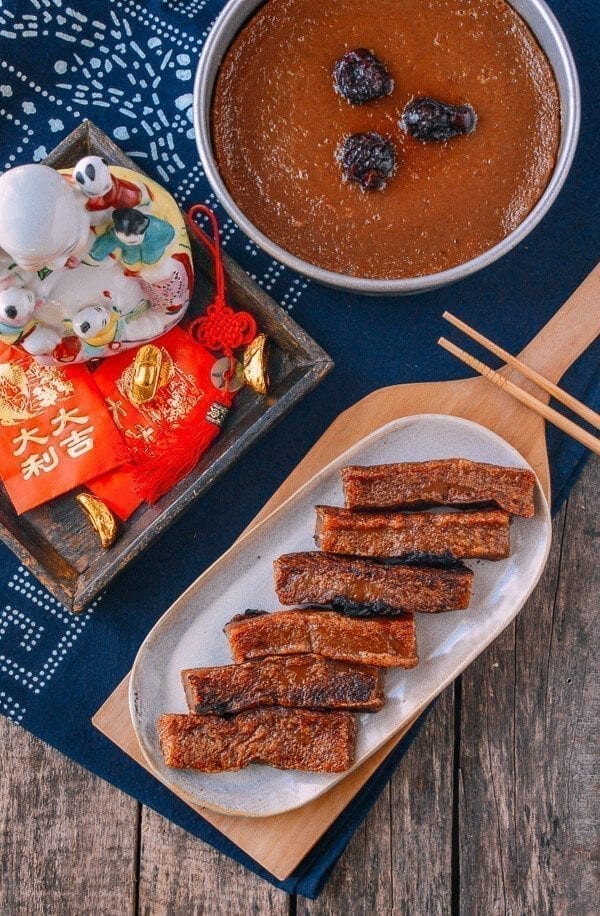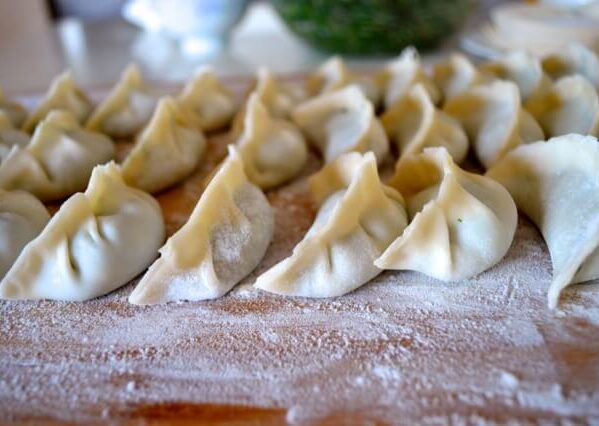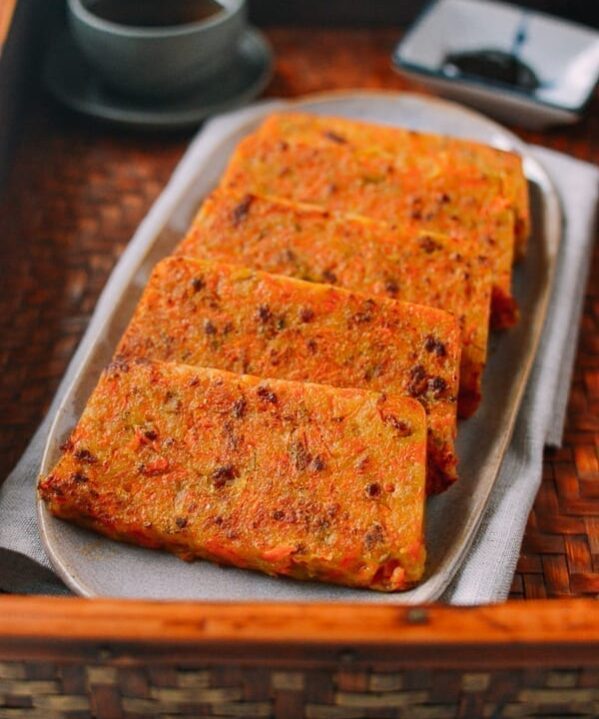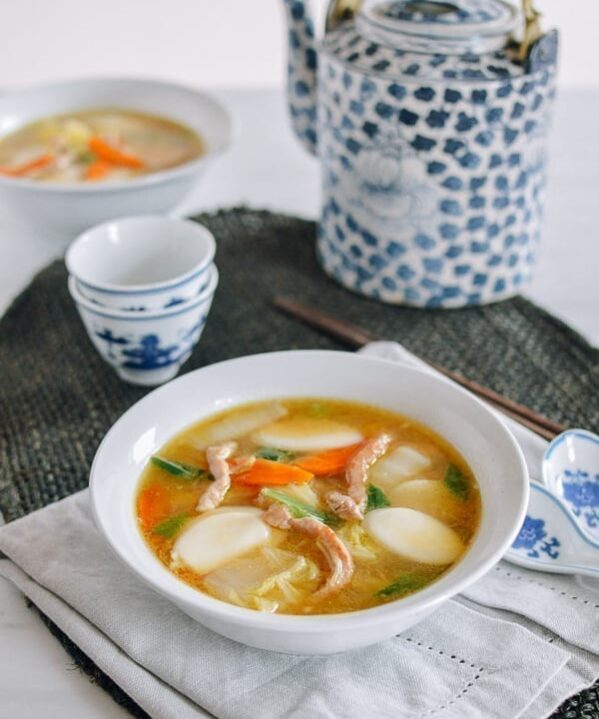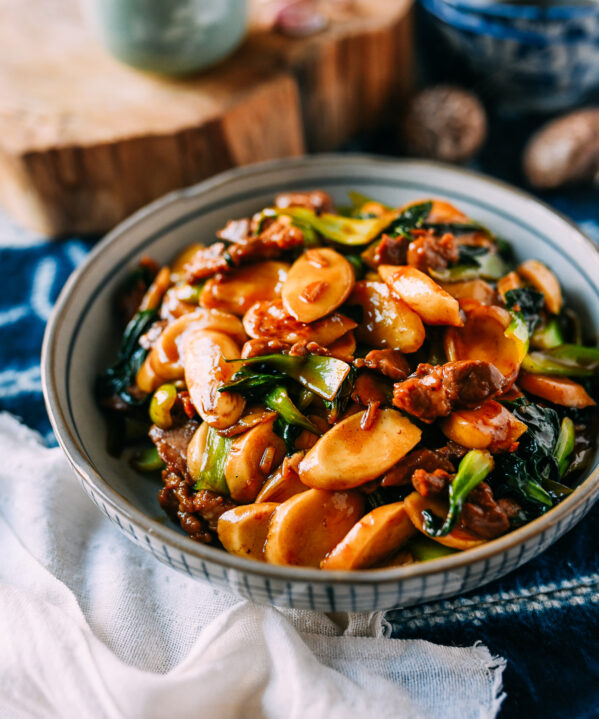The familiar image of a New Year Sweet Rice Cake (红糖年糕), or nian gao, is a welcome sight during Chinese New Year.
Nian gao 年糕 symbolizes progress, advancement, and growth. Nián (年) means “year,” and “gāo” (糕) is a homonym for “gāo” (高), which means, “tall,” “high,” or “expensive.”
Every family inevitably buys or makes this treat for their Chinese New Year celebration, in the hopes of having a better year ahead. It’s also a popular gift to give when visiting family and friends during the holiday.
Note: We originally published this recipe in January 2016. Five years later, we’re re-posting it with metric measurements, nutrition info, and more! Enjoy!
My Version of Sweet Nian Gao
Just so you know, this Chinese New Year Sweet Rice Cake recipe is a bit non-traditional. Before you think harshly of me, allow me to explain.
I know all about the traditional sweet rice cake recipe. It takes three to four ingredients: sugar, water and regular and glutinous rice flours.
Feel free to follow the cooking instructions and make the traditional version using just those basic ingredients listed below. I know many people are looking for that taste from home or from their childhood.
But to me, I just feel that the traditional nian gao recipe is a bit too plain and could use some improvement.
So, I adapted some western baking elements to come up with this recipe. I have to say, I’m quite pleased with it—dare I say, proud of it?The addition of ginger and orange zest really enhances the subtle flavor of the nian gao.
So basically, this recipe is based on the traditional version, but has a bit of oomph! Many readers have asked for a Sweet Nian Gao recipe over the past year, and I hope you’ll like my version of this Chinese New Year staple. I think it’s quite lovely!
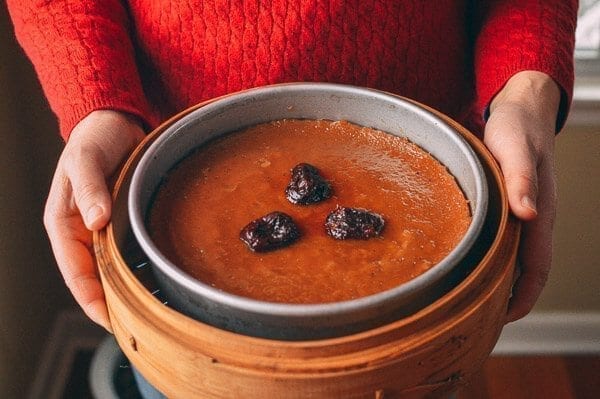
A few things you might want to know about nian gao:
1) If you like Chinese dried dates, feel free to remove the pits from a handful of them, chop them up, and mix them in with the batter. The dates would be a great addition.
2) If you want to give these away as gifts, use a foil pan!
3) You can eat the rice cake right away. Just remember that it’s very sticky and gooey when hot. I think the best way to enjoy this Sweet Rice Cake is wait for it to cool, slice it, and then pan fry both sides with a bit of vegetable oil over medium heat.
4) You can refrigerate or freeze Sweet Rice Cakes. They will harden, but they reheat nicely in a pan when sliced (as described above).
5) This recipe makes two 8” round rice cakes.
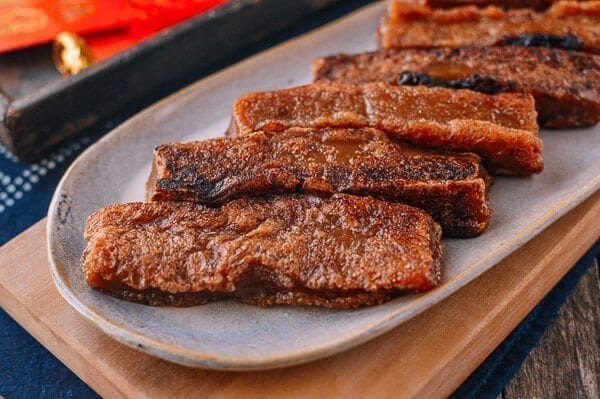
Nian Gao Recipe Instructions
Prepare two 8-inch round baking pans by brushing the insides with vegetable oil.
Add 2 cups of water and the ginger to a medium-sized pot, bring it a boil, then let it simmer for 10 minutes over low to medium heat with the lid covered.
Turn off the heat. Stir in the Chinese Brown Rock Sugar and allspice until the sugar dissolves completely. Remove the ginger slices. Now add 1 1/2 cups of cold water to cool down the mixture so its warm, not hot.
In a large mixing bowl, mix the glutinous rice flour and rice flour together, and then slowly add in the sugar water mixture.
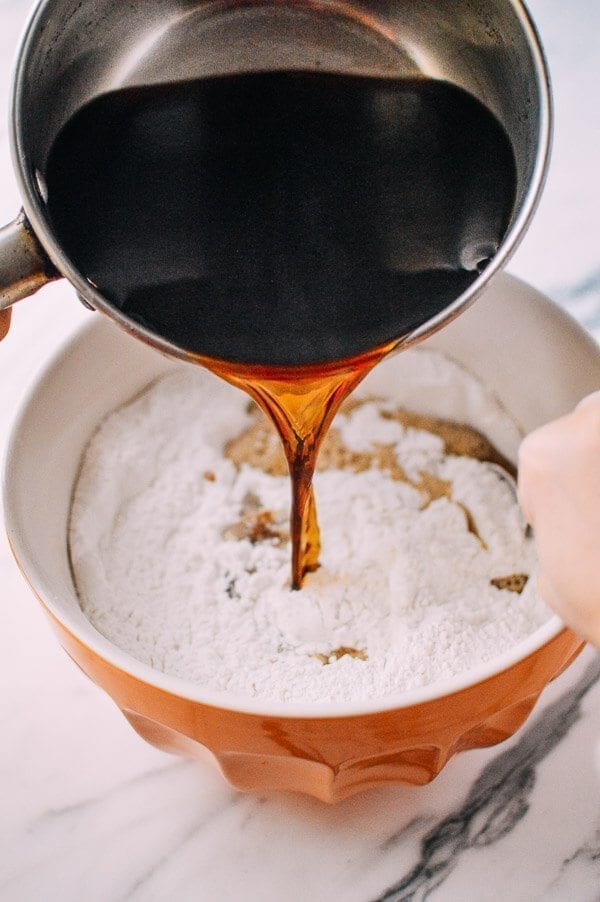
Stir thoroughly until the batter is smooth (without any lumps). Now stir in the vanilla extract, molasses, orange zest, and 2 teaspoons of vegetable oil until thoroughly combined.
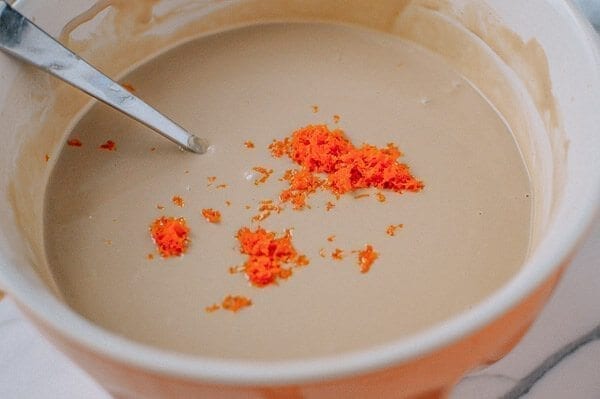
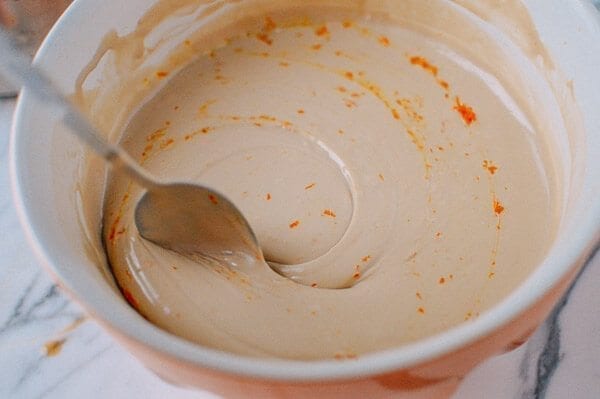
The resulting batter should have a consistency similar to condensed milk. If the batter is too thick, add a bit more water a couple tablespoons at a time until the desired consistency is reached.
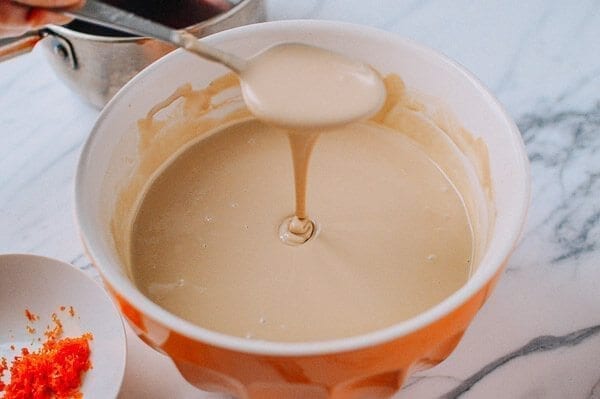
Pour the batter evenly into two foil pans. Gently tap the pans against your countertop to get rid of air bubbles. Top each pan with three decorative dried dates in the center, if using.
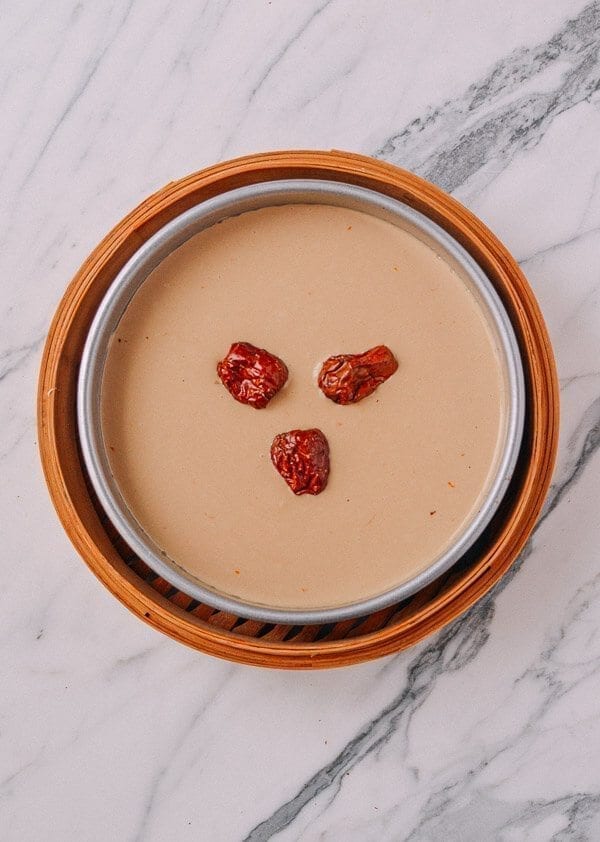
Put both pans in a double-decker bamboo steamer and steam for about 1 hour on high heat (the water should be boiling, but should NOT be bubbling high enough to touch the foil pans).
You might need to add hot water into the steamer midway to avoid having the water dry up and burn your bamboo steamers.
After 1 hour, poke a toothpick into the rice cake. It’s done if the toothpick comes out clean—just like a regular cake!
Regarding steaming techniques, for this recipe and in general, it doesn’t matter what type of vessel you use. The core goal here is to use steam to cook the food, which means it’s important that the steam doesn’t escape.
For example, if you use bamboo steamer, you will also need a pot that fits the bamboo steamer perfectly so there is no visible steam escaping.
If you don’t have a pot that fits the bamboo steamer, you will need to put the bamboo steamer inside a much larger pot with a lid and set the bamboo steamer on a rack above the water. (Read more about different steaming set-ups.)
Whatever you decide to use, with the correct set up, you should not see steam escaping!
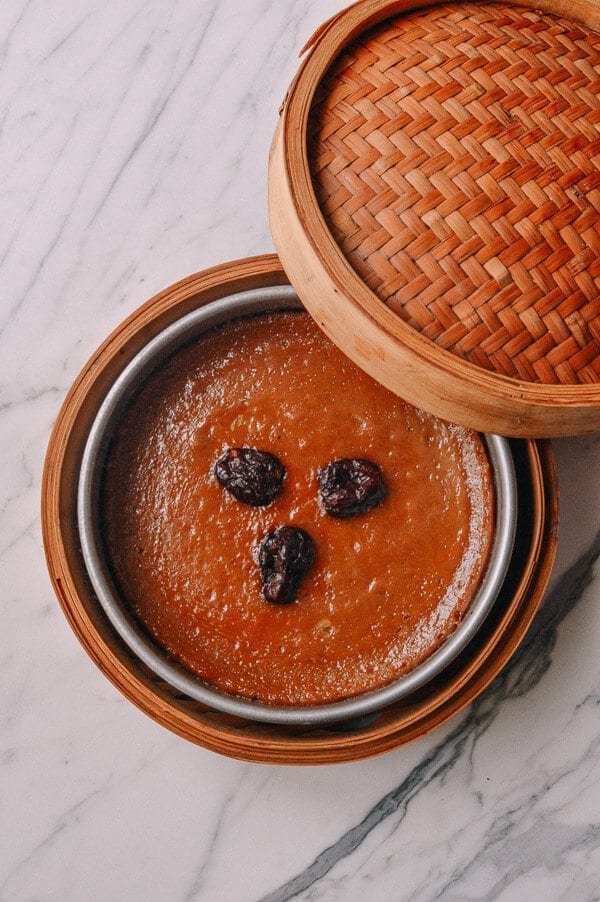
Again, I like to make these ahead of Chinese New Year. When we’re ready to enjoy, I slice the cooled cake into pieces and pan-fry the pieces on all sides in a cast iron pan with a little canola oil.

Enjoy this sweet Nian Gao for Chinese New year!
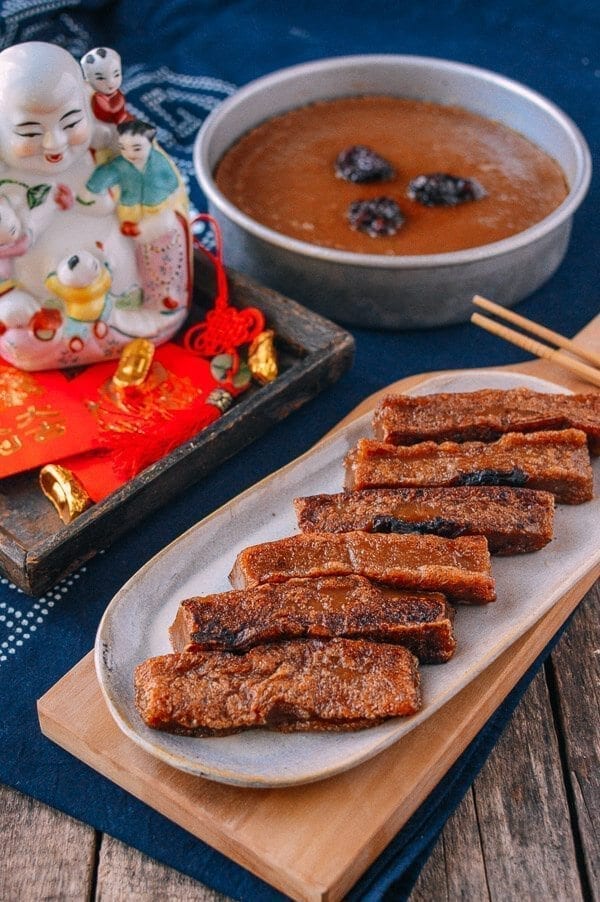
Chinese New Year Sweet Rice Cake (Nian Gao)
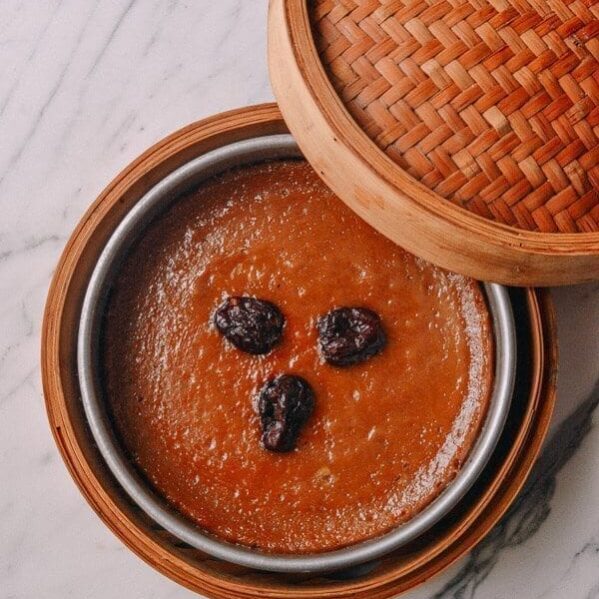
Ingredients
- 2 teaspoons vegetable oil (plus more for brushing baking pans)
- 3½ to 4 cups of water (depending on humidity levels where you are)
- 4 slices ginger
- 2 cups dark brown sugar or brown rock sugar
- ½ teaspoon allspice powder
- 1½ pounds glutinous rice flour (one and a half bags, as they generally come in 1-pound bags)
- ½ pound rice flour (about half a bag)
- 1 tablespoon vanilla extract
- 1 tablespoon dark molasses
- zest of 1 large orange
- 6 dried dates (for decoration, optional)
Instructions
- Prepare two 8-inch round baking pans by brushing the insides with vegetable oil.
- Add 2 cups of water and the ginger to a medium-sized pot, bring it a boil, then let it simmer for 10 minutes over low to medium heat with the lid covered. Turn off the heat, and stir in the brown sugar and allspice until the sugar is dissolved completely. Remove the ginger slices. Now add 1 1/2 cups of cold water to cool down the mixture so its warm, not hot.
- In a large mixing bowl, mix the two kinds of flours together and then slowly add in the sugar water mixture. Stir thoroughly until the batter is smooth (without any lumps). Now stir in the vanilla extract, molasses, orange zest, and 2 teaspoons of vegetable oil until thoroughly combined. The resulting batter should have a consistency similar to condensed milk. If the batter is too thick, add a bit more water a couple tablespoons at a time until the desired consistency is reached.
- Pour the batter evenly into two foil pans. Gently tap the pans against your countertop to get rid of air bubbles. Top each pan with three decorative dates in the center, if using. Put both pans in a double-decker bamboo steamer and steam for about 1 hour on high heat (the water should be boiling, but should NOT be bubbling high enough to touch the foil pans). You might need to add water into the steamer midway to avoid having the water dry up and burn your bamboo steamers.
- After 1 hour, poke a toothpick into the rice cake. It’s done if the toothpick comes out clean–just like a regular cake! Regarding steaming techniques, for this recipe and in general, it doesn’t matter what type of vessel you use. The core goal here is to use steam to cook the food, which means it’s important that the steam doesn’t escape.
- For example, if you use bamboo steamer, you will also need a pot that fits the bamboo steamer perfectly so there is no visible steam escaping. If you don’t have a pot that fits the bamboo steamer, you will need to put the bamboo steamer inside a much larger pot with a lid and set the bamboo steamer on a rack above the water. Whatever you decide to use, with the correct set up, you should not see steam escaping!
